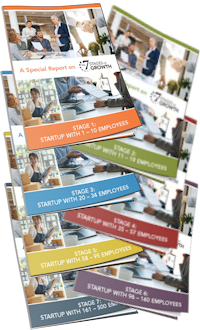Unique to our programs is our laser-like focus on the 7 Stages of Growth companies move through as they grow. What works for your business when you have 20 employees is far different than what will work for you when you are staring at 125 employees. And even more critical to a company’s success is the leader’s attitude about growth.
Let us introduce you to this unique, research-proven model that has helped thousands of business owners get the traction they need to not just sustain growth but understand the issues facing them as they move from one stage of growth to another.

Rule 1
The movement from one stage of growth to another begins as soon as you land in any stage of growth.
Rule 2
What you don’t get done in a specific stage of growth doesn’t go away
Rule 3
Time will make a difference
Rule 4
If you aren’t growing, you are dying
“Nowhere have I ever found an incisive, insightful analytical tool like that offered by the 7 Stages of Growth that makes charting a company’s growth as easy as painting by numbers.”
What Stage of Growth are you in?
Creating a sustainable, thriving enterprise takes time, patience and planning. And it takes practicing the art of intentionality and knowing how to navigate through the various stages of enterprise growth.
As a business owner who recognizes and understands these powerful stages of growth you are better able to:
- Initiate, manage and complete your change initiatives
- Improve the outcome of your decisions
- Calibrate the impact you, as a leader, have on your company’s performance
- Manage and advance the forces driving your company’s profitability
- Resonate and respond to the hidden agents influencing your work community

How to take the guesswork out of growing your business
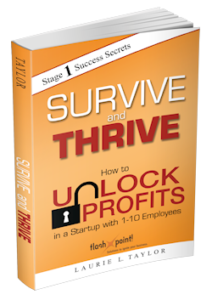 The honeymoon is over. You have your start up capital, you ramped up to 4 – 6 employees pretty quickly and now the fun begins.
The honeymoon is over. You have your start up capital, you ramped up to 4 – 6 employees pretty quickly and now the fun begins.
Getting out of the gate with a new company isn’t easy but it’s a cake walk compared to creating a consistently profitable business that you can run and not have it run you.
I talk to business owners every day. They are struggling to keep their focus on the constant barrage of issues they have to deal with in a fast-growing enterprise that has quickly grown beyond the owner’s ability to manage everything.
That happens, by the way, as soon as you start adding full time employee to the mix.
In a six year research study of entrepreneurial company’s along the Front Range and Silicon Valley, the trigger to growth trauma wasn’t brought on by an increase in revenue/sales or profits. It was brought on by an increase in the number of people in a company.
Intuitively, business owners know when growth trauma is occurring. I knew it as I grew a company from 2 employees to over 100 employees. I recognized the signs of growth impact early on in our company’s life cycle when we watched profits dip, customer satisfaction decline, morale issues surface.
What I didn’t understand was the exact reasons, except for a general belief that it was harder and harder to keep pace with the requirements the additional people we brought on board demanded and the feeling that what we did last week no longer was working this week.
Wish I knew then what I know now.
The complexity of any organization is created because of the number of people, not the amount of revenue, you have. Money and processes are easy to manage compared to the dynamic impact that people bring to the table.
This entrepreneurial research study turned into an enterprise development model that I use daily in my consulting practice with business owners.
This model helps business owners get ahead of growth issues, actually allows them to predict growth impact and helps them understand what they have to do to manage their company as they add more people.
A Stage 1 company, (there are 7 Stages that cover companies up to 500 employees) or Start Up, has 1 – 10 employees.
A Stage 1 company is CEO centric – meaning the CEO is likely the ‘specialist’ who has created a product or service and is now getting their idea to take shape. Therefore, 50% of your time should be spent as the technician or the specialist while only 10% of your time will be spent as a manager.
The Five Non-Negotiable Leadership Rules for a Stage 1 company:
- You must generate, track and preserve cash
- You must focus 80% of your resources on selling the 2 – 3 offerings with the best margins
- You must hire for ‘how the person fits in with the team’ first and second, for how competent they are
- Waste no time trying to ‘stabilize’ your company – embrace chaos – command the team and inspire the employees
- Establish regular one-on-one meetings with each employee designed to build a company-wide performance mindset, feedback loop and employee development
As a company grows, so must the leader. Each stage of growth will require something different from the leader. Understanding what is required of you as your company evolves can either propel the company forward or cause the company to become ‘stuck’ – profits never materialize; sales suffer; there is high employee turnover.
Survival is the name of the game in a Stage 1 company. As you grow closer to Stage 2 (10 – 19 employees) it shifts to being about growth. Stage 2 is about supporting higher sales levels and making a profit.
The bottom line in understanding the 7 stages of growth that all companies go through is that the complexity of an organization will always extract its due. Understanding what’s coming is the real value in understanding each stage of a company’s growth.
All of FlashPoint!’s programs are designed to focus on your stage of growth. If you are a stage 1 company, we can provide you with the top five challenges for your stage of growth. We can get you focused on the ‘rules of the road’ for a company with 1 – 10 employees. And we can help you get ready for the day you add that next employee and flip you into the next stage of growth.
Get your FREE Stage of Growth Report!
Read about the challenges you are facing today and what your primary goals are based on your current stage of growth. Understand your strategic and leadership perspective as well as the four rules that govern this research-based model.
You’ll learn what your top five challenges are and ideas on how to create the necessary balance between chaos and equilibrium as you grow. Read about your Non-Negotiable Rules (and they are non-negotiable!) and the critical building blocks necessary to manage growth.
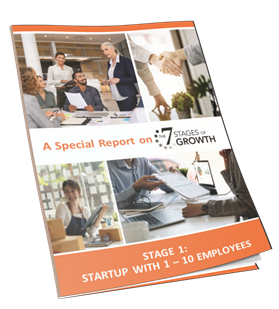

Keep the Momentum: Focus on These Critical Challenges
 You aren’t sure when it happened. But without really being cognizant of it, you have 14 employees. Fourteen people who now rely on you to ‘bring home the bacon’ so they can fry it up at home.
You aren’t sure when it happened. But without really being cognizant of it, you have 14 employees. Fourteen people who now rely on you to ‘bring home the bacon’ so they can fry it up at home.
Ouch. You knew things were getting more difficult to manage. It was getting harder and harder to keep up with the flow of work. Your employees were sending you ‘not so subtle’ messages that unless you did something soon to ease their pain, it was you they might be ‘frying’.
You are now the proud owner of a Stage 2 company with between 11 – 19 employees. You just experienced what is referred refers as a Flood Zone, one of two ‘chaos zones’ that companies move through as they grow. A Flood Zone requires you to bear up to an increase in the quantity of activity. Your first reaction to a Flood Zone is to add more people. Don’t.
Instead, as you Ramp Up in Stage 2, you need to be focused on Profit/Revenue, getting critical processes in place and avoid the trap of just ‘throwing people at your problems’.
This mistake alone has accounted for too many businesses imploding too soon. There are five critical challenges you face as a Stage 2 leader. In talking to leaders who have made it to Stage 2, they are almost completely overwhelmed.
You probably haven’t spent time thinking about ‘managers’ or shifting the responsibility of managing these 14 people – you are not only trying to keep them on target with projects, but you are still doing everything you’ve been doing since you started your business.
Based on recent research, getting focused on five specific areas of your company will help. I know you have more than five things you have to worry about. I get that. I’d just offer up this approach to the following five top challenges of a Stage 2 leader.
When you get out of bed every morning, spend time organizing your day around these five activities. Make the commitment that you will address each one, at some level, every day.
Challenge #1:
Hiring Quality People. But, Laurie, you just said: Don’t throw people at your problems! I’m not asking you to hire more people, I’m asking you to hire quality people. My guess is you have one or two people on your staff right now that the company has outgrown. They are good people but the company has moved on and they haven’t. Let them go and hire someone you can begin delegating specific tasks to.
Challenge #2:
Improve Sales. You are no longer in survival mode. You have moved into growth mode. That’s why generating revenue through sales is so critical. Follow the money. Enough said.
Challenge #3:
Manage Cash Flow. Track it daily if necessary but no less than weekly. Don’t let your expenses get ahead of you. When thinking about spending money on something, take time and ‘inquire’ as to the WHY of your decision. Ninety percent of CEOs think they make good decisions – 60% of them are a bust. This isn’t time to squander resources.
Challenge #4:
Recognize the Leadership/Staff Gap. If you aren’t talking to your staff, individually, on a weekly basis – and I mean having a dialogue about how they are doing, what they need, how you can help them – you are looking at the beginnings of a communication chasm that you won’t be able to bridge. Start talking now – payoff is in spades.
Challenge #5:
Limited Capital to Grow. This is a challenge that has dogged you potentially since day one. It is reality for companies in Stage 1 and Stage 2 who haven’t received venture funds. Have you looked at your business model? Do you have a model that creates a recurring revenue stream? Passive income? Have you recently evaluated your pricing model? Don’t get complacent. Worse, don’t spend all your time working IN your business. Intentionally think about your business.
Congrats on making it to Stage 2!
All of FlashPoint!’s programs are designed to focus on your stage of growth. If you are a stage 2 company, we can provide you with the top five challenges for your stage of growth. We can get you focused on the ‘rules of the road’ for a company with 11 – 19 employees. And we can help you get ready for the day you add that next employee and flip you into the next stage of growth.
Get your FREE Stage of Growth Report!
Read about the challenges you are facing today and what your primary goals are based on your current stage of growth. Understand your strategic and leadership perspective as well as the four rules that govern this research-based model.
You’ll learn what your top five challenges are and ideas on how to create the necessary balance between chaos and equilibrium as you grow. Read about your Non-Negotiable Rules (and they are non-negotiable!) and the critical building blocks necessary to manage growth.
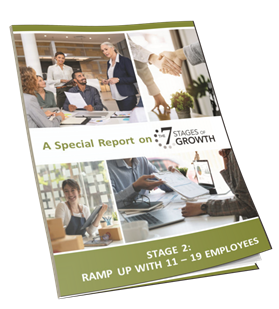

No Longer CEO-Centric: Time to Start Letting Go
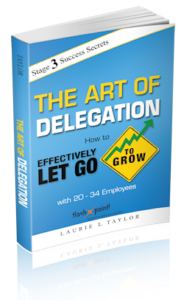 Hang on to your sanity, your world just shifted.
Hang on to your sanity, your world just shifted.
The dynamic that occurs when a company moves to Stage 3 with 20 – 34 employees is unlike anything you’ve been through. Up to this point in the company’s history, it’s been CEO-centric – your passion, your vision, your blood, sweat and tears have carried the company successfully to this point.
With the addition of employee #20, a strange phenomenon occurs. We liken it to when your preteen, who use to think you walked on water, now thinks you’re dumb and dumber. You are just a few months away from a staff revolution. You’ve felt the subtle change – your employees are a bit harder to manage, they push back more often, their attitude hits you in the face when you least expect it – you seem to be at odds with them on a daily basis.
Here’s a hint. Don’t look at them – look at yourself. Your company just hit a wall in how you manage it and it’s you who has to make some changes — quickly.
A couple of critical forces are hitting at the same time. In Stage 1 and Stage 2, a company is CEO-centric. When you move into Stage 3, it becomes Enterprise-centric. It’s too big for you to continue to ‘wear all the hats’. It’s time to start ‘passing those hats’ around to the incredibly talented people you have hired.
You have also just come through a Wind Tunnel – a chaos zone that requires you to let go of methodologies that no longer work and adapt new ones that do.
That’s a lot for any CEO to deal with.
Stage 3 has the highest incident of CEO-burnout of any stage of growth and it’s not difficult to understand. Suddenly you have to start managing, delegating and team building like there was no tomorrow. The top 5 challenges for a Stage 3 company include:
- Staff buy-in
- Leadership/staff gap
- Weak business design
- Unclear core values
- Staff is resistant to change
Four out of five of your top challenges center around people issues. If I’ve heard it once, I’ve heard it a thousand times from business owners – the lament that starts with ‘If I just didn’t have to deal with employees’.
It’s no wonder that as a company moves into this critical stage of growth that many CEOs lose some of the enthusiasm, the passion that was their ‘life line’ up to now. You could always call on your ‘life line’ to get you through those tough times. Now you have to start relying on your people – relying is a bit soft. You have to start ‘trusting, believing, managing, training, teaching, coaching, rewarding, caring and communicating’ with each and every person in your company. And you have to do it daily.
Want to know how to avoid the ‘staff revolution’? One word: Communication.
And lots of it. Now. Today. Tomorrow. Next week. Next month.
In a workshop the other day, I mentioned that a manager should meet with their direct reports once a week for at least 30 minutes. One participant quickly did the math for their 9 reports: ‘You want me to spend 4 1/2 hours a week talking to my employees? Who has that kind of time?’
There’s your staff revolution.
Your employees are just as excited about the success of your company as you are. Give them a chance to succeed. As a leader, you have to evaluate your leadership style and ask yourself: is my style hindering the success of this company? If you tend to lean on the micro-manage, command and control approach to managing people, you’re in trouble.
Stage 3 demands that you start letting go and start bringing your key people into the fold. Many companies never make it past Stage 3 – the revolving door starts early. When you hire smart, capable people and they aren’t allowed to be smart or capable, they will leave. Wouldn’t you? Put yourself in their shoes. Tap into the intelligence of every single person in your company.
Now you know how to avoid the revolution. Good luck!
All of FlashPoint!’s programs are designed to focus on your stage of growth. If you are a stage 3 company, we can provide you with the top five challenges for your stage of growth. We can get you focused on the ‘rules of the road’ for a company with 20 – 34 employees. And we can help you get ready for the day you add that next employee and flip you into the next stage of growth.
Get your FREE Stage of Growth Report!
Read about the challenges you are facing today and what your primary goals are based on your current stage of growth. Understand your strategic and leadership perspective as well as the four rules that govern this research-based model.
You’ll learn what your top five challenges are and ideas on how to create the necessary balance between chaos and equilibrium as you grow. Read about your Non-Negotiable Rules (and they are non-negotiable!) and the critical building blocks necessary to manage growth.
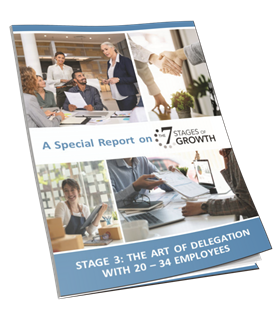

Complexity Level Increasing: Focus on Experienced Managers
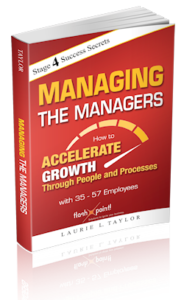 This isn’t the time to think about saving money by hiring inexperienced managers. In Stage 4, with 35 – 57 employees, you are in need of managers who ‘have been there, done that’.
This isn’t the time to think about saving money by hiring inexperienced managers. In Stage 4, with 35 – 57 employees, you are in need of managers who ‘have been there, done that’.
And the CEO is now spending at least 70% of their time ‘managing’. Getting the right people on board to take your company through this stage of growth is all about bringing on experienced managers, creating management systems and maintaining your market position.
Still hanging onto your need to control everything? Still playing specialist or out there ‘visioning’ your next opportunity? Sorry – wrong time, wrong focus.
Stage 4 is all about Internal Focus, it’s all about Internal Processes. If you need to be convinced, here are your top 5 Challenges for a Stage 4 company:
- Weak project management
- Difficulty diagnosing problems
- Employee turnover
- Not getting systems in place
- Your organization is uniformed about company growth
Remember Stage 3? It was all about delegation, all about you, the CEO letting go. The necessity of that lesson will become painfully clear if you head into Stage 4 looking like a cat dangling from your living room drapes – you have to LET GO!
Why is one of your challenges ’employee turnover’? Because if you haven’t started getting ‘strong, experienced managers’ in place, your employees will leave. Remember, people stay at a company because they respect their manager. If you can begin to provide your employees with managers who know how to manage the work of the company, as well as manage the people, your employees feel less frustrated, work fewer hours, are way more productive and receive solid input on their performance on a regular basis.
Stage 4 is also about helping each manager feel confident about their team, about their work, about their own identity as a team. Your job is to help them gain that confidence. Don’t worry about integrating these managers across the company just yet. Help them find ‘their own way’, work with them to be accountable as their team evolves and matures. You will avoid a lot of finger-pointing and department disputes if you let each manager build a stronghold and develop their own sense of commitment and team-ness.
Are you getting the message here?
This isn’t just about ‘training’ qualified people to move up in your organization. Yes, that can be done, however experience tells us that it’s generally just an easy way for a CEO to avoid doing the harder work – finding experienced, already trained people already hardwired to help them grow their business.
Successful CEOs surround themselves with knowledgeable, experienced people – they want to be challenged on decisions, knowing that the more diversity of ideas and even attitude they bring on board, the more depth they create in their organization.
As you moved from Stage 3 to Stage 4, you also went through another Flood Zone: an increase in the level of activity. Because you are teetering on shifting the major control of your company over to experienced managers, remember to focus on key processes, key systems that will provide you foundational building blocks to manage that shift.
Your company is growing up. The biggest question to ask yourself is ‘are you’?
All of FlashPoint!’s programs are designed to focus on your stage of growth. If you are a stage 4 company, we can provide you with the top five challenges for your stage of growth. We can get you focused on the ‘rules of the road’ for a company with 35 – 57 employees. And we can help you get ready for the day you add that next employee and flip you into the next stage of growth.
Get your FREE Stage of Growth Report!
Read about the challenges you are facing today and what your primary goals are based on your current stage of growth. Understand your strategic and leadership perspective as well as the four rules that govern this research-based model.
You’ll learn what your top five challenges are and ideas on how to create the necessary balance between chaos and equilibrium as you grow. Read about your Non-Negotiable Rules (and they are non-negotiable!) and the critical building blocks necessary to manage growth.
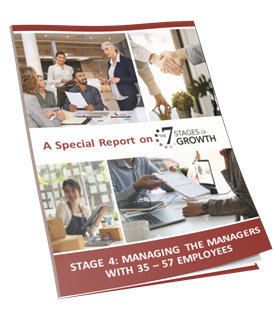

Alignment, Integration: Stage 5 is All About Synergy
 You’ve moved beyond 50 employees. I remember experienced business owners telling me as President of a growing company, “Watch out. When you get to 50 employees, everything changes.” My frustration was that no one would tell me exactly what those changes would be.
You’ve moved beyond 50 employees. I remember experienced business owners telling me as President of a growing company, “Watch out. When you get to 50 employees, everything changes.” My frustration was that no one would tell me exactly what those changes would be.
Because of the 7 Stages of Growth enterprise development model, I can shed some light on exactly what those business owners were cautioning me about and hopefully save you hours and days of frustration.
As a Stage 5 company, you have 58 – 95 employees. The company is beginning to align itself – sales and marketing understands and is involved with product development. Customer service is tied into every aspect of your operation. As the CEO, you are operating in a proactive, systematic approach instead of a reactive, scattered approach. You have trained and/or hired qualified managers and their divisions are operating on solid ground.
There’s a subtle difference now that you have ‘breached the 50’ – while managing this dynamic organization is your number one priority, you have to shift ever so slightly into a more visionary role. No longer invisible to the outside world, your competition is heating up because you are now playing in a larger fishbowl.
Your top 5 challenges include:
- Improving sales – Of the three gates of growth: Profit/Revenue, Process and People, your #1 priority is Profit/Revenue. Because you are entering a larger competitive domain, you need to focus more of your energy developing new opportunities and cementing key relationships with current customers.
- Difficulty forecasting problems– Larger is harder and in Stage 5 it’s easier for problems to simmer underneath your radar and create cracks in your armor. Staying alert, not allowing mediocrity to set in, paying attention to the little things (never assume your vision and values are safe), will help you continually stay ahead of the tidal waves that can sink your ship.
- Cost of lost expertise – Your second priority of the gates of growth is People. It’s harder and harder for your employees to feel ‘valued’. It’s more difficult for you, the CEO, to ‘touch’ every single person in the organization. You need to maintain a constant vigilance to stay on top of how your managers are aligning employee performance to company goals. That’s the hard part. The easy part is for your employees to disengage because they aren’t feeling ‘valued’ and decide the grass is greener someplace else.
- Weak profit design – Focusing on Value Exchange, Organizational Structure, Business Development, Operating Systems, and Knowledge Management is a good place to start in evaluating your profit design as you move into Stage 5. Assuming what worked before will continue to work is a mistake many leaders make as the company grows beyond their capacity to manage all aspects of their business.
- Staff training – Do each of your departments have their own budget with spending discretion? Do they understand gross margins, how the company makes and keeps money? Is there an intentional training program in place for all employees that is focused on company goals? How much of your budget have you allocated to training? For my money, training your staff on Company Goals, Company Issues and Company Priorities is far more productive at this stage of growth then sending them to expensive conferences and outside training programs.
Where Stage 4 was all about developing strong independent departments, Stage 5 is all about Integration. Because you took the time to develop strong fiefdoms, the art of integration will be much smoother.
You lead by showing that you value people’s input and you work to get commitment through participation, not dictation. Having spent the time and energy to build a great team, look to them for guidance and advice in their areas of expertise.
Teamwork and collaboration is crucial as you lead your team into the future.
All of FlashPoint!’s programs are designed to focus on your stage of growth. If you are a stage 5 company, we can provide you with the top five challenges for your stage of growth. We can get you focused on the ‘rules of the road’ for a company with 58 – 95 employees. And we can help you get ready for the day you add that next employee and flip you into the next stage of growth.
Get your FREE Stage of Growth Report!
Read about the challenges you are facing today and what your primary goals are based on your current stage of growth. Understand your strategic and leadership perspective as well as the four rules that govern this research-based model.
You’ll learn what your top five challenges are and ideas on how to create the necessary balance between chaos and equilibrium as you grow. Read about your Non-Negotiable Rules (and they are non-negotiable!) and the critical building blocks necessary to manage growth.
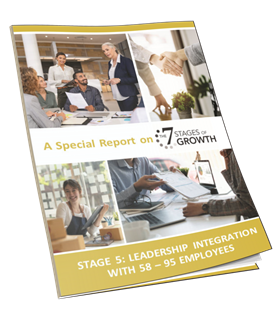

Compete from Strength by Developing a Strategic Perspective
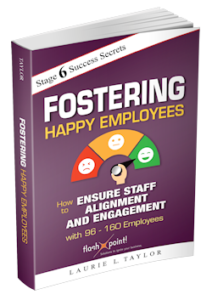 There’s a rhythm now.
There’s a rhythm now.
Patterns of behavior have been established, processes are in place, the morning walk through your company has an air of familiarity that feels good. Feels comfortable. Your confidence in your staff is strong.
If you’ve captured the imagination of your managers, they now provide the stability to make good decisions, connect with their direct reports, and provide sound input that keeps you updated on critical issues.
This level of engagement is critical in Stage 6 because it’s time for you to, once again, shift your view, your attention and your energy. The company must pay strong attention to its strategic orientation in the market place. With 96 – 160 employees, it’s time to look beyond the arena you have built and prepare to take the company into a more challenging competitive environment.
You must set in motion the longer view, move from an annual planning perspective into a multi-year strategic perspective and drive the organizational culture as a visible leader. Emphasis is once again on people as your top growth gate with profit/revenue as a second priority.
Your top 5 challenges include:
- The need to have better staff-buy in
- The impact that staff satisfaction has on the company’s profitability
- New staff orientation
- Strengthening a weak profit design
- Hiring quality staff
As a leader of a Stage 6 company, you must engage a unique blend of managerial and visionary styles. Orchestrating a company’s move into Stage 6 requires a leader who believes strongly in the power of effective and consistent communication. Your leadership style must help create synergy by connecting people to each other, be able to heal rifts in a team, and motivate during stressful times.
It’s also time to revisit some areas that you might assume are okay:
How’s the vision? Still clear? Just make sure you’ve revisited this with your management team to make sure there’s not been any erosion. This doesn’t happen because people don’t believe in the stated vision, it happens because you’ve trained and developed strong-minded staff – they will be testing and questioning the direction of the company.
Values still driving behavior? Again, check in frequently with how these are being adhered to in your company. Are the values still a part of determining who gets hired? Are people making decisions based on those values?
If your vision and values have survived the complexity level you’ve grown to, then your culture should be well defined. Any erosion of the culture you wanted to create will manifest itself clearly at this stage of the company’s growth.
Do you have a powerful strategic plan in place? More critical than ever is your ability to put a strategic plan in place that focuses the company’s resources on opening up new markets, refreshing products and/or services and directing the company’s future growth.
I remember when I was running a company at this stage of growth the overwhelming feeling that a shift was needed in our thinking, in our planning, in our ability to look ahead and plan for the future. We brought on a Board of Directors. We brought in outside resources to help us evaluate and challenge our current status. We got uncomfortable again.
Remember that rhythm we talked about? Time to orchestrate a new score.
All of FlashPoint!’s programs are designed to focus on your stage of growth. If you are a Stage 6 company, we can provide you with the top five challenges for your stage of growth. We can get you focused on the ‘rules of the road’ for a company with 96 – 160 employees. And we can help you get ready for the day you add that next employee and flip you into the next stage of growth.
Get your FREE Stage of Growth Report!
Read about the challenges you are facing today and what your primary goals are based on your current stage of growth. Understand your strategic and leadership perspective as well as the four rules that govern this research-based model.
You’ll learn what your top five challenges are and ideas on how to create the necessary balance between chaos and equilibrium as you grow. Read about your Non-Negotiable Rules (and they are non-negotiable!) and the critical building blocks necessary to manage growth.
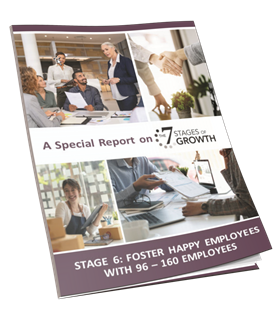

Even If You Don’t Think It’s Broke, Shake Things Up
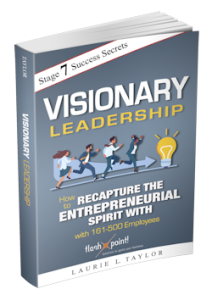 What a view. From where you sit, as the CEO of an organization with 161 – 500 employees, you have the right to be proud.
What a view. From where you sit, as the CEO of an organization with 161 – 500 employees, you have the right to be proud.
How many of us ever sit back and simply bask in the pleasure of being successful? If you are like most CEOs, you spend very little time in reflection of where you have come from – you move quickly on to your next challenge, your next successful endeavor.
Stage 7, the Visionary stage of growth, offers great opportunity while throwing even larger challenges your way.
The phrase “You can tame a wild duck but you can’t make a tame duck wild”, speaks volumes about a CEO’s challenges in Stage 7. Management’s efforts to professionalize the company often crush the entrepreneurial spirit that is so necessary in order not to be left behind by other, newer entrepreneurial firms.
Because of your size, your company has started to form layers of bureaucracy that quickly impede performance and growth.
As you ‘listen’ to your direct reports and employees talking around the proverbial ‘water cooler’, are you hearing:
“That’s the way it’s always been done, I don’t know why they want us to change.”
“We really don’t have the right people on board to make that change.”
“No one cares about what I’m doing, so why should I care?”
“I don’t know what’s going on – they never tell us anything anymore.”
If there is one thing I know from experience, if you aren’t telling your employees what’s going on, they are making it up on their own. And their ‘fill in the blanks’ verbiage is MUCH different than yours. Theirs is full of fear, uncertainty, negative speak and ‘attitude’.
Your primary role as the leader is to spend 75% of your time as the Visionary. You need to engage, excite and empower your employees to think about and see the new vision of where the company is going from here.
Spend time communicating the vision, the strategic plan, and your desire to maintain the entrepreneurial spirit of the company that got you where you are today. And then make sure you are ‘walking your talk.’
Don’t let your company fall prey to the ‘invisible employee’ syndrome. You now have enough employees in your company that the mediocre ones can simply ‘fall through the cracks’. You know what I’m talking about. You have employees in your company that just aren’t performing at the level they should.
It’s sometimes easy to overlook them, allowing these employees to become ‘invisible’ and if you do, you are making a mistake. Don’t let them become an invisible negative force in your company – either focus on raising their performance level or part ways.
A company in Stage 7 will have an overwhelming tendency to gravitate toward safety and equilibrium. It will start to act like a large company – its decision making is slower, the product innovation is slower, and the bureaucracy is formidable.
It’s harder to respond as quickly as a younger, more agile organization. Your job as the leader in a company of this size – along with sustaining and propagating the vision of the company – is to create a degree of disequilibrium and chaos within the enterprise.
Your goal? Create a corporate culture that supports entrepreneurial endeavors.
How? Start by going through your company lighting fires of inspiration and innovation. Be relentless in allowing mistakes in the pursuit of new endeavors.
Get out from underneath the strategic and operational challenges in order to identify and carve out new opportunities.
Your top 5 challenges include:
- Weak product/service development and differentiation in market
- Profits are inadequate to grow the company
- Too slow getting new products/services to market
- The need for an improved profit design
- The marketplace and your customers change too quickly
Recapturing the entrepreneurial spirit that you had when you were a much smaller, much more nimble company is critical. Identifying new opportunities, fostering exploration, developing action plans and assigning the necessary resources to manifest those plans is your new paradigm.
All of FlashPoint!’s programs are designed to focus on your stage of growth. If you are a stage 7 company, we can provide you with the top five challenges for your stage of growth. We can get you focused on the ‘rules of the road’ for a company with 161 – 500 employees. And we can help you get ready for the day you add that next employee and flip you into the next stage of growth.
Get your FREE Stage of Growth Report!
Read about the challenges you are facing today and what your primary goals are based on your current stage of growth. Understand your strategic and leadership perspective as well as the four rules that govern this research-based model.
You’ll learn what your top five challenges are and ideas on how to create the necessary balance between chaos and equilibrium as you grow. Read about your Non-Negotiable Rules (and they are non-negotiable!) and the critical building blocks necessary to manage growth.
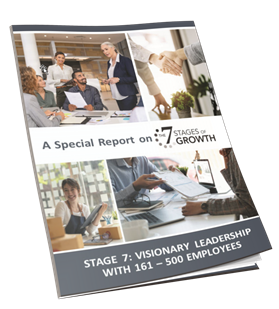
Receive your own FREE Stages of Growth report based on your current business size.
Please complete the form below:
